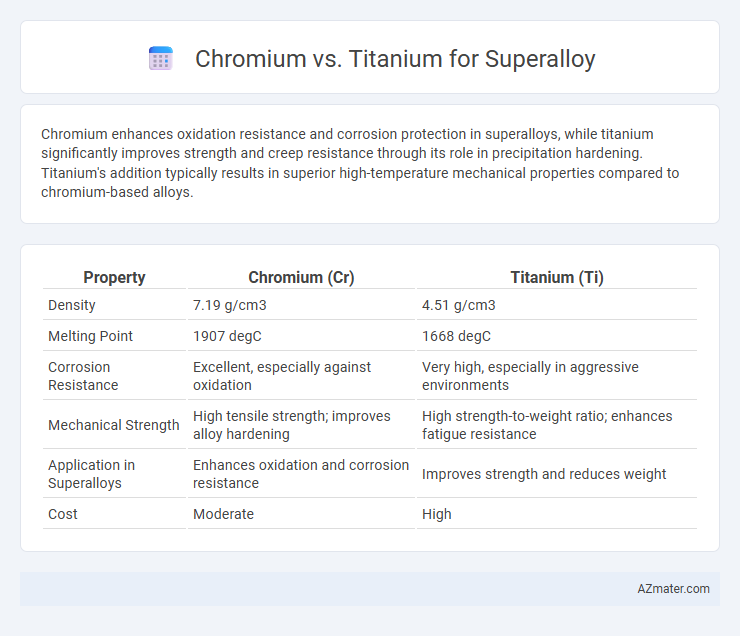Chromium enhances oxidation resistance and corrosion protection in superalloys, while titanium significantly improves strength and creep resistance through its role in precipitation hardening. Titanium's addition typically results in superior high-temperature mechanical properties compared to chromium-based alloys.
Table of Comparison
| Property | Chromium (Cr) | Titanium (Ti) |
|---|---|---|
| Density | 7.19 g/cm3 | 4.51 g/cm3 |
| Melting Point | 1907 degC | 1668 degC |
| Corrosion Resistance | Excellent, especially against oxidation | Very high, especially in aggressive environments |
| Mechanical Strength | High tensile strength; improves alloy hardening | High strength-to-weight ratio; enhances fatigue resistance |
| Application in Superalloys | Enhances oxidation and corrosion resistance | Improves strength and reduces weight |
| Cost | Moderate | High |
Introduction to Superalloys
Superalloys are advanced metal alloys designed to maintain exceptional strength and resistance to oxidation and corrosion at high temperatures, often employed in aerospace and power generation industries. Chromium enhances superalloys by improving oxidation resistance and surface stability, while titanium contributes to strength and phase stability through solid solution strengthening and the formation of gamma prime precipitates. The optimal balance between chromium and titanium content is critical for tailoring superalloy performance to endure extreme environments.
Overview of Chromium and Titanium
Chromium, a transition metal known for its high corrosion resistance and hardness, significantly enhances superalloy durability and oxidation resistance at elevated temperatures. Titanium offers exceptional strength-to-weight ratio and excellent corrosion resistance, making it ideal for superalloy applications requiring reduced weight and high mechanical performance. Both elements play critical roles in superalloy formulations used in aerospace, power generation, and industrial gas turbines to improve thermal stability and mechanical strength.
Chemical Properties Comparison
Chromium offers excellent corrosion resistance and forms a stable oxide layer, enhancing oxidation resistance in superalloys, while titanium provides superior strength-to-weight ratio and improves high-temperature stability due to its strong affinity for interstitial elements like oxygen and nitrogen. Chromium's high melting point (1907degC) supports thermal endurance, whereas titanium's lower melting point (1668degC) demands careful alloy design to maintain structural integrity at elevated temperatures. Chemical compatibility with reactive elements and resistance to carburization make chromium essential for superalloy oxidation protection, while titanium's chemical properties contribute to grain refinement and creep resistance.
Mechanical Strength and Durability
Chromium enhances superalloy mechanical strength by improving corrosion resistance and oxidation stability at high temperatures, making it essential for maintaining durability in harsh environments. Titanium contributes to superalloy strength by promoting precipitation hardening and grain refinement, leading to improved fatigue resistance and structural stability. Both elements optimize superalloy performance, with chromium prioritizing environmental resistance and titanium enhancing mechanical toughness and long-term durability.
Corrosion and Oxidation Resistance
Chromium enhances superalloy corrosion resistance by forming a stable, protective oxide layer that prevents further surface degradation in high-temperature oxidizing environments. Titanium improves oxidation resistance by promoting the formation of adherent and corrosion-resistant oxide scales, but excessive titanium content can lead to the formation of brittle phases reducing overall durability. Balancing chromium and titanium concentrations optimizes superalloy performance, achieving superior resistance to oxidation and corrosion in demanding aerospace and power generation applications.
Applications in Aerospace and Industrial Sectors
Chromium enhances superalloy oxidation resistance and high-temperature strength, making it essential for aerospace turbine blades and industrial gas turbines operating under extreme thermal conditions. Titanium contributes to superior corrosion resistance and exceptional strength-to-weight ratio, benefiting aerospace airframe components and industrial equipment where weight reduction and mechanical durability are critical. Combining chromium and titanium in superalloys optimizes performance in aerospace engines and heavy industrial machinery, balancing thermal stability with structural integrity.
Thermal Stability and Performance
Chromium enhances the thermal stability of superalloys by forming a stable oxide layer that resists oxidation at high temperatures, improving corrosion resistance and performance in harsh environments. Titanium contributes to superalloy strength through the formation of gamma prime (g') precipitates, which significantly increase high-temperature creep resistance and mechanical stability. While Chromium mainly boosts oxidation resistance, Titanium is crucial for maintaining mechanical integrity in turbine blades and jet engines under extreme thermal stress.
Cost and Availability Factors
Chromium offers a cost-effective solution for superalloy production due to its widespread availability and lower extraction expenses compared to titanium. Titanium's cost remains significantly higher because of complex processing methods and limited natural reserves, impacting overall superalloy pricing. The abundant supply of chromium enhances its feasibility for large-scale manufacturing, while titanium's scarcity restricts its use to specialized high-performance applications.
Environmental and Safety Considerations
Chromium in superalloys provides excellent corrosion resistance but poses environmental risks due to hexavalent chromium compounds, which are toxic and require careful handling and disposal protocols. Titanium offers superior biocompatibility and lower toxicity, making it a safer choice in applications demanding environmental sustainability and human safety. Manufacturing processes involving titanium generate fewer hazardous byproducts, reducing environmental impact and workplace health hazards compared to chromium-based superalloys.
Future Trends in Superalloy Development
Chromium enhances oxidation resistance and corrosion protection in superalloys, while titanium contributes to improved strength and phase stability at high temperatures. Future trends in superalloy development emphasize optimizing the chromium-titanium balance to achieve superior creep resistance and thermal stability for aerospace and power generation applications. Advanced alloy design techniques, such as machine learning and additive manufacturing, are accelerating the tailoring of chromium and titanium content to meet evolving industry demands.

Infographic: Chromium vs Titanium for Superalloy
 azmater.com
azmater.com